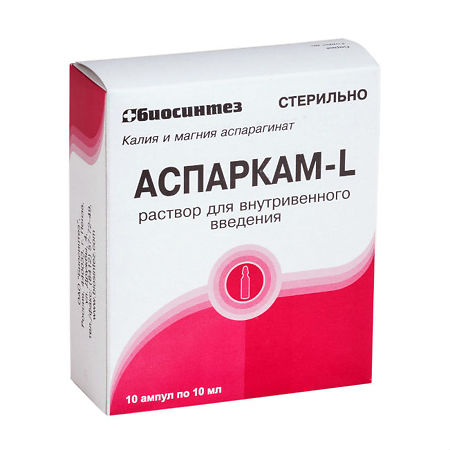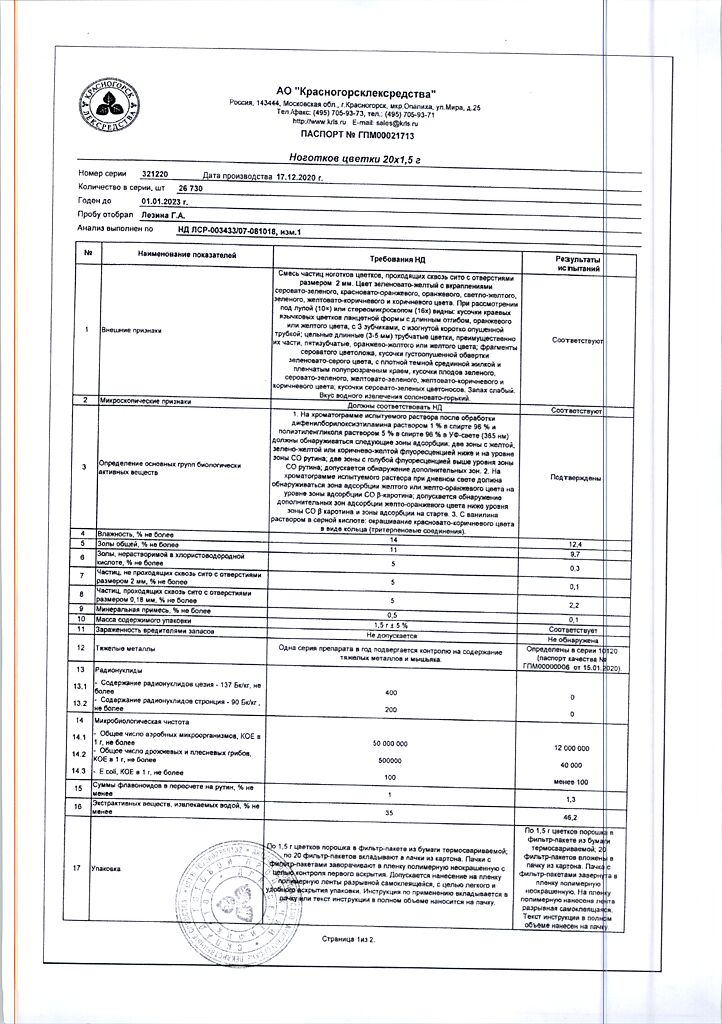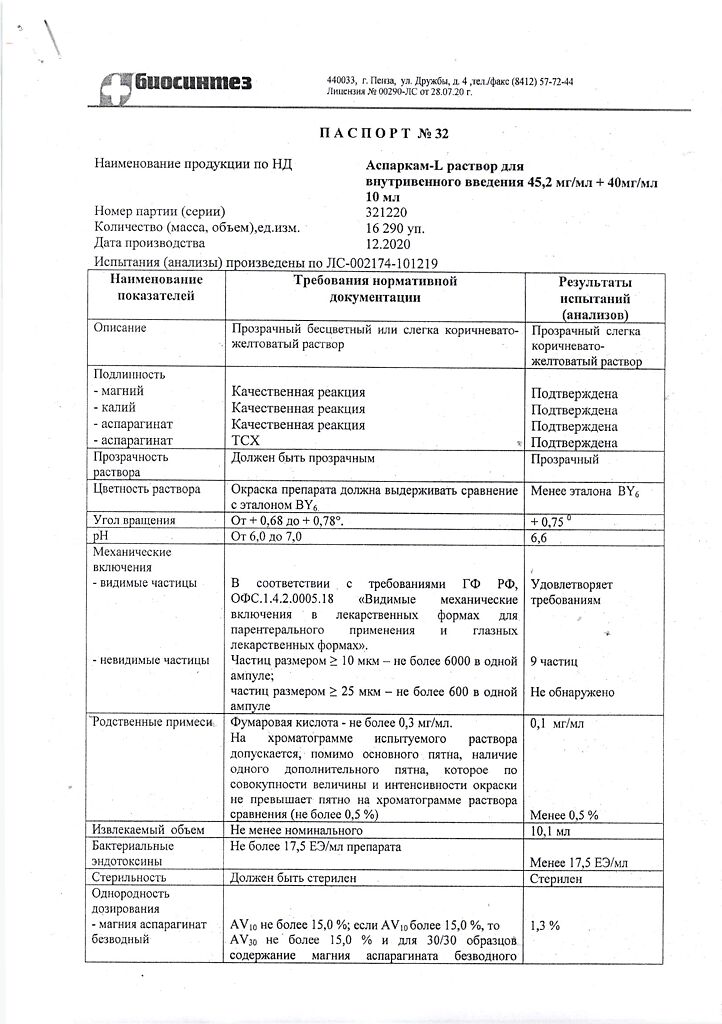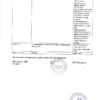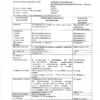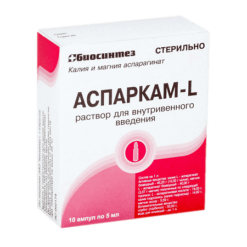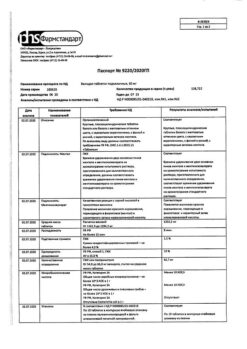No products in the cart.
Asparkam-L, 45.2mg/ml+40 mg/ml 10 ml 10 pcs
€3.44 €3.05
Description
Elimination of potassium and magnesium deficiency, normalization of electrolyte balance, improvement of myocardial metabolism. The mechanism of action of the drug is associated with the effective participation of L-asparaginate in the transport of magnesium and potassium ions into the intracellular space.
Magnesium activates sodium-potassium-ATPase, removing sodium ions from the cell and returning potassium ions; it reduces sodium content and prevents its exchange for calcium in vascular smooth muscle, reducing their resistance. Potassium stimulates the synthesis of adenosine triphosphate, glycogen, proteins, acetylcholine, etc.
The two ions maintain polarization/cell membranes. The drug regulates the conduction of impulses along nerve fibers, synaptic transmission, muscle contraction, and heart muscle function. Due to magnesium ions it participates in the processes of energy input and expenditure, normalizes membrane permeability, neuromuscular conduction, deoxyribonucleic acid and ribonucleic acid synthesis, cell growth, cell division, oxygen assimilation, and phosphate synthesis.
Indications
Indications
To eliminate potassium and magnesium deficiency as an adjuvant for various manifestations of coronary heart disease, including acute myocardial infarction; chronic circulatory failure; heart rhythm disturbances (arrhythmias caused by an overdose of cardiac glycosides).
Pharmacological effect
Pharmacological effect
Elimination of potassium and magnesium deficiency, normalization of electrolyte balance, improvement of metabolism in the myocardium. The mechanism of action of the drug is associated with the effective participation of L-aspartate in the transport of magnesium and potassium ions into the intracellular space.
Magnesium activates sodium-potassium ATPase, removing sodium ions from the cell and returning potassium ions; reduces sodium content and prevents its exchange for calcium in vascular smooth muscles, reducing their resistance. Potassium stimulates the synthesis of adenosine triphosphate, glycogen, proteins, acetylcholine, etc.
Both ions support polarization of cell membranes. The drug regulates the conduction of impulses along nerve fibers, synaptic transmission, muscle contraction, and the functioning of the heart muscle. Due to magnesium ions, it participates in the processes of energy intake and expenditure, normalizes membrane permeability, neuromuscular conductivity, synthesis of deoxyribonucleic and ribonucleic acids, cell growth, cell division, oxygen uptake, and phosphate synthesis.
Special instructions
Special instructions
No studies have been conducted to assess the effect of the drug on the ability to drive vehicles and engage in other potentially hazardous activities that require increased concentration and speed of psychomotor reactions.
Active ingredient
Active ingredient
Potassium aspartate, Magnesium aspartate
Composition
Composition
Active ingredients:
potassium L-aspartate anhydrous – 45.20 g (10.33 g potassium),
magnesium L-aspartate anhydrous – 40.00 g (3.37 g magnesium),
received according to the following formula:
L-aspartic acid – 74.00 g,
potassium hydroxide (potassium hydroxide) – 14.82 g,
magnesium oxide – 5.59 g
Excipients:
sorbitol (sorbitol) – 50.00 g,
water for injections – up to 1 l.
Contraindications
Contraindications
Hypersensitivity to the drug, sorbitol, hyperkalemia, hypermagnesemia, acute and chronic renal failure, adrenal insufficiency, atrioventricular block II and III degrees, cardiogenic shock, oliguria – anuria, acute metabolic acidosis, myasthenia gravis, dehydration, Addison’s disease, arterial hypotension, pregnancy, lactation, age up to 18 years (efficacy and safety have not been established).
Side Effects
Side Effects
Possible nausea, dizziness, facial flushing, thirst, low blood pressure, hyporeflexia. The phenomena usually disappear when the dose of the drug is reduced.
With rapid intravenous administration, all symptoms of hyperkalemia and hypermagnesemia may appear.
Hyperkalemia (nausea, vomiting, diarrhea, paresthesia) and hypermagnesemia (facial skin hyperemia, thirst, bradycardia, decreased blood pressure, muscle weakness, fatigue, paresis, coma, areflexia, respiratory depression, convulsions); with parenteral administration – atrioventricular block, paradoxical reaction (increased number of extrasystoles), phlebitis.
Interaction
Interaction
Potassium-sparing diuretics (triamterene, spironolactone), beta-blockers, cyclosporine, heparin, angiotensin-converting enzyme inhibitors, non-steroidal anti-inflammatory drugs – the risk of developing hyperkalemia up to the development of arrhythmia and asystole.
Eliminates hypokalemia caused by glucocorticosteroids.
Reduces the undesirable effects of cardiac glycosides.
Due to the content of magnesium ions, it reduces the effect of neomycin, polymyxin B, tetracycline and streptomycin.
Anesthetics enhance the inhibitory effect of magnesium on the central nervous system.
May enhance neuromuscular blockade caused by depolarizing muscle relaxants (atracurium besylate, decamethonium bromide, suxamethonium (chloride, bromide, iodide)).
Calcitriol increases the concentration of magnesium in the blood plasma, calcium preparations reduce the effect of magnesium.
The solution is pharmaceutically compatible with solutions of cardiac glycosides (improves their tolerability).
Storage conditions
Storage conditions
At temperatures from 0 to 25°C.
Shelf life
Shelf life
2 years
Manufacturer
Manufacturer
Biosynthesis, Russia
Additional information
| Shelf life | 2 years |
|---|---|
| Conditions of storage | At temperatures from 0 to 25°C. |
| Manufacturer | Biosintez, Russia |
| Medication form | solution |
| Brand | Biosintez |
Other forms…
Related products
Buy Asparkam-L, 45.2mg/ml+40 mg/ml 10 ml 10 pcs with delivery to USA, UK, Europe and over 120 other countries.

